Foundation Skills in Data Analysis: TechnoMart Industries Report
VerifiedAdded on 2023/06/07
|8
|2277
|308
Report
AI Summary
This report presents an analysis of TechnoMart's employee data, focusing on key areas such as overtime, union membership, and pre-tax income. The analysis reveals a significant overtime problem, with many employees exceeding the 40-hour work week. The study found that union membership doesn't significantly affect working hours, and union members generally report lower satisfaction levels. The report identifies EmpYears as the most significant predictor of pre-tax income and dismisses concerns about imminent retirement. Furthermore, the analysis questions the validity of the union's claims regarding employee loyalty and weekly working hours. The report concludes by recommending a larger sample size for future surveys to improve the reliability of the findings.
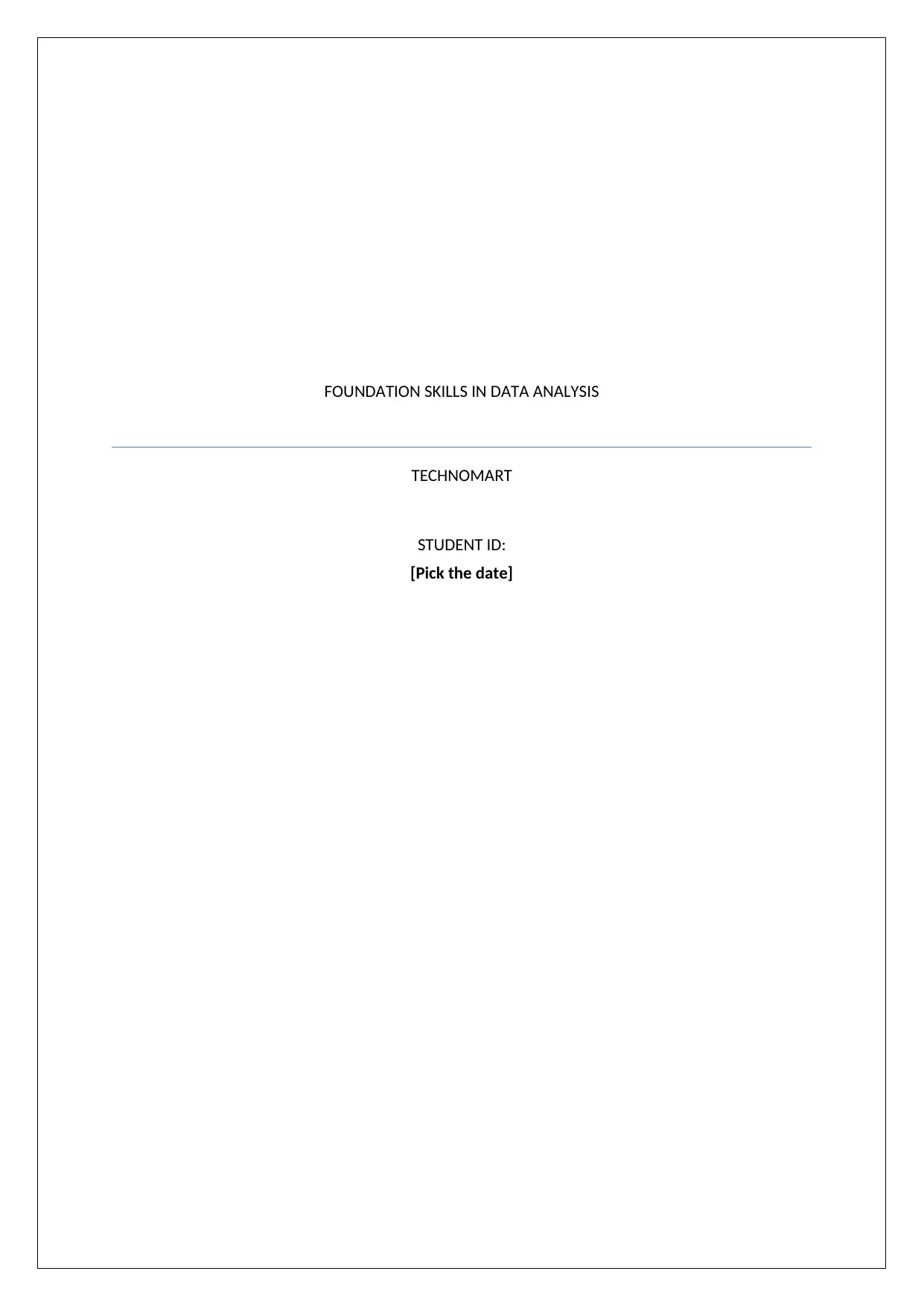
FOUNDATION SKILLS IN DATA ANALYSIS
TECHNOMART
STUDENT ID:
[Pick the date]
TECHNOMART
STUDENT ID:
[Pick the date]
Paraphrase This Document
Need a fresh take? Get an instant paraphrase of this document with our AI Paraphraser
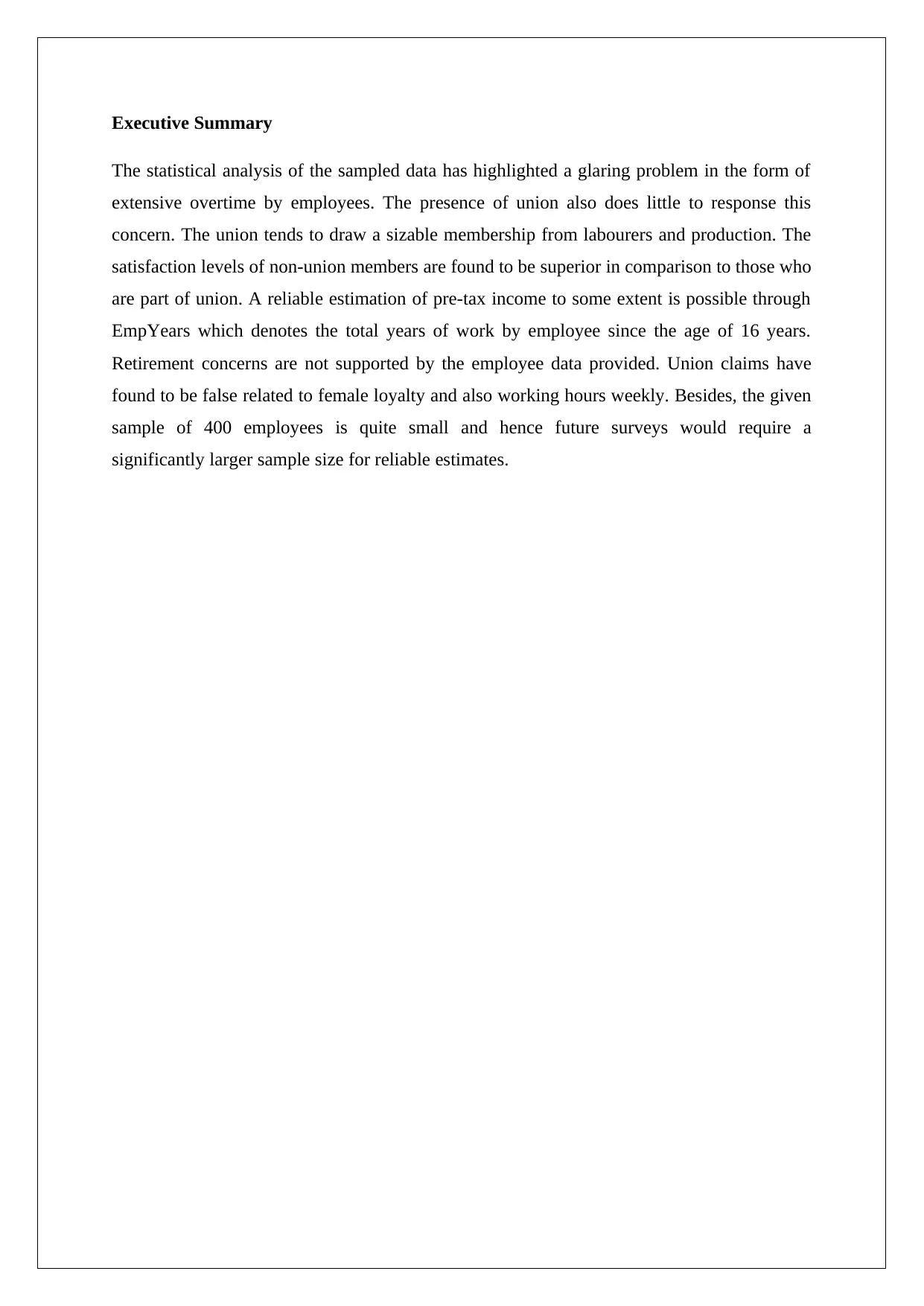
Executive Summary
The statistical analysis of the sampled data has highlighted a glaring problem in the form of
extensive overtime by employees. The presence of union also does little to response this
concern. The union tends to draw a sizable membership from labourers and production. The
satisfaction levels of non-union members are found to be superior in comparison to those who
are part of union. A reliable estimation of pre-tax income to some extent is possible through
EmpYears which denotes the total years of work by employee since the age of 16 years.
Retirement concerns are not supported by the employee data provided. Union claims have
found to be false related to female loyalty and also working hours weekly. Besides, the given
sample of 400 employees is quite small and hence future surveys would require a
significantly larger sample size for reliable estimates.
The statistical analysis of the sampled data has highlighted a glaring problem in the form of
extensive overtime by employees. The presence of union also does little to response this
concern. The union tends to draw a sizable membership from labourers and production. The
satisfaction levels of non-union members are found to be superior in comparison to those who
are part of union. A reliable estimation of pre-tax income to some extent is possible through
EmpYears which denotes the total years of work by employee since the age of 16 years.
Retirement concerns are not supported by the employee data provided. Union claims have
found to be false related to female loyalty and also working hours weekly. Besides, the given
sample of 400 employees is quite small and hence future surveys would require a
significantly larger sample size for reliable estimates.
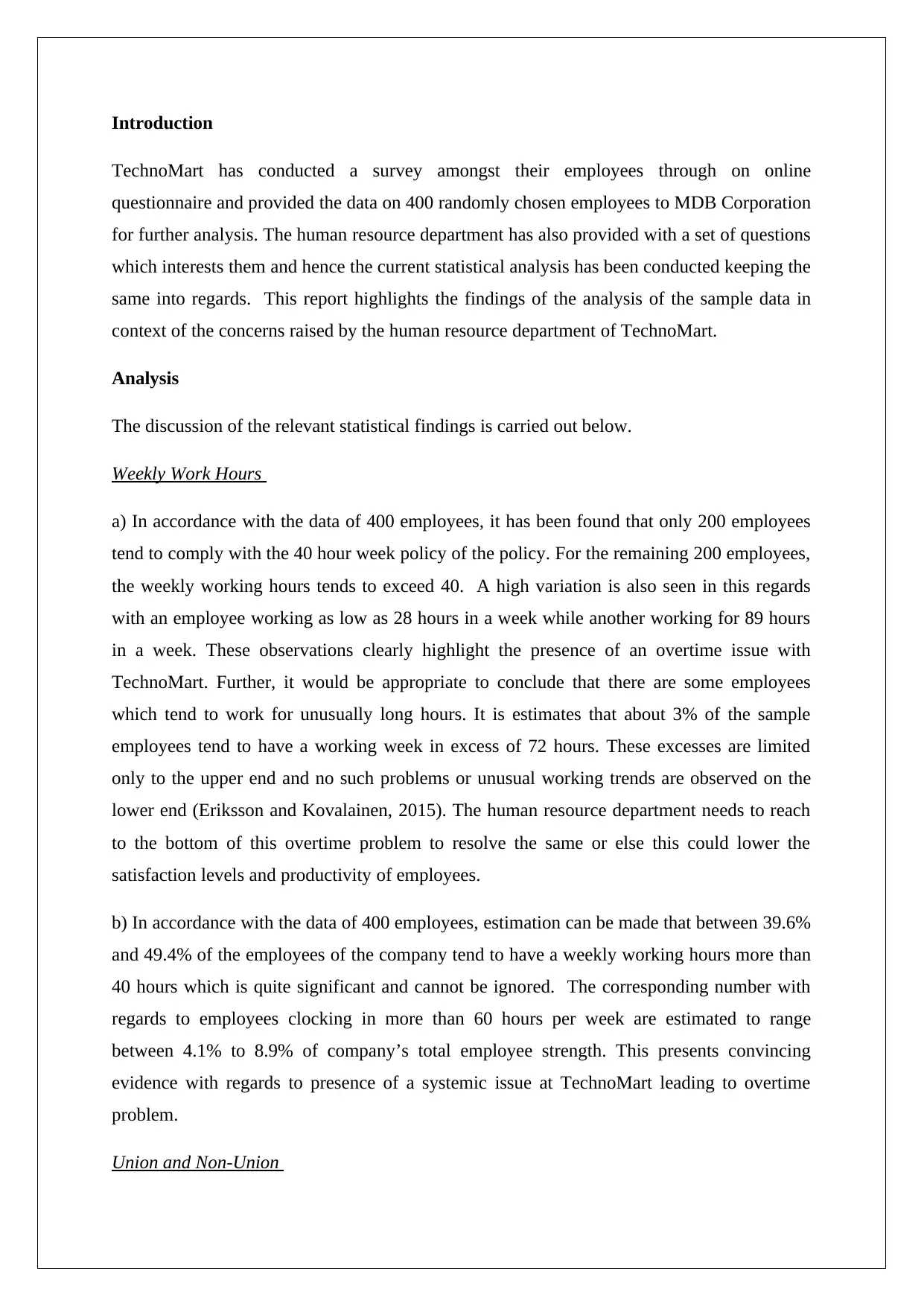
Introduction
TechnoMart has conducted a survey amongst their employees through on online
questionnaire and provided the data on 400 randomly chosen employees to MDB Corporation
for further analysis. The human resource department has also provided with a set of questions
which interests them and hence the current statistical analysis has been conducted keeping the
same into regards. This report highlights the findings of the analysis of the sample data in
context of the concerns raised by the human resource department of TechnoMart.
Analysis
The discussion of the relevant statistical findings is carried out below.
Weekly Work Hours
a) In accordance with the data of 400 employees, it has been found that only 200 employees
tend to comply with the 40 hour week policy of the policy. For the remaining 200 employees,
the weekly working hours tends to exceed 40. A high variation is also seen in this regards
with an employee working as low as 28 hours in a week while another working for 89 hours
in a week. These observations clearly highlight the presence of an overtime issue with
TechnoMart. Further, it would be appropriate to conclude that there are some employees
which tend to work for unusually long hours. It is estimates that about 3% of the sample
employees tend to have a working week in excess of 72 hours. These excesses are limited
only to the upper end and no such problems or unusual working trends are observed on the
lower end (Eriksson and Kovalainen, 2015). The human resource department needs to reach
to the bottom of this overtime problem to resolve the same or else this could lower the
satisfaction levels and productivity of employees.
b) In accordance with the data of 400 employees, estimation can be made that between 39.6%
and 49.4% of the employees of the company tend to have a weekly working hours more than
40 hours which is quite significant and cannot be ignored. The corresponding number with
regards to employees clocking in more than 60 hours per week are estimated to range
between 4.1% to 8.9% of company’s total employee strength. This presents convincing
evidence with regards to presence of a systemic issue at TechnoMart leading to overtime
problem.
Union and Non-Union
TechnoMart has conducted a survey amongst their employees through on online
questionnaire and provided the data on 400 randomly chosen employees to MDB Corporation
for further analysis. The human resource department has also provided with a set of questions
which interests them and hence the current statistical analysis has been conducted keeping the
same into regards. This report highlights the findings of the analysis of the sample data in
context of the concerns raised by the human resource department of TechnoMart.
Analysis
The discussion of the relevant statistical findings is carried out below.
Weekly Work Hours
a) In accordance with the data of 400 employees, it has been found that only 200 employees
tend to comply with the 40 hour week policy of the policy. For the remaining 200 employees,
the weekly working hours tends to exceed 40. A high variation is also seen in this regards
with an employee working as low as 28 hours in a week while another working for 89 hours
in a week. These observations clearly highlight the presence of an overtime issue with
TechnoMart. Further, it would be appropriate to conclude that there are some employees
which tend to work for unusually long hours. It is estimates that about 3% of the sample
employees tend to have a working week in excess of 72 hours. These excesses are limited
only to the upper end and no such problems or unusual working trends are observed on the
lower end (Eriksson and Kovalainen, 2015). The human resource department needs to reach
to the bottom of this overtime problem to resolve the same or else this could lower the
satisfaction levels and productivity of employees.
b) In accordance with the data of 400 employees, estimation can be made that between 39.6%
and 49.4% of the employees of the company tend to have a weekly working hours more than
40 hours which is quite significant and cannot be ignored. The corresponding number with
regards to employees clocking in more than 60 hours per week are estimated to range
between 4.1% to 8.9% of company’s total employee strength. This presents convincing
evidence with regards to presence of a systemic issue at TechnoMart leading to overtime
problem.
Union and Non-Union
⊘ This is a preview!⊘
Do you want full access?
Subscribe today to unlock all pages.

Trusted by 1+ million students worldwide
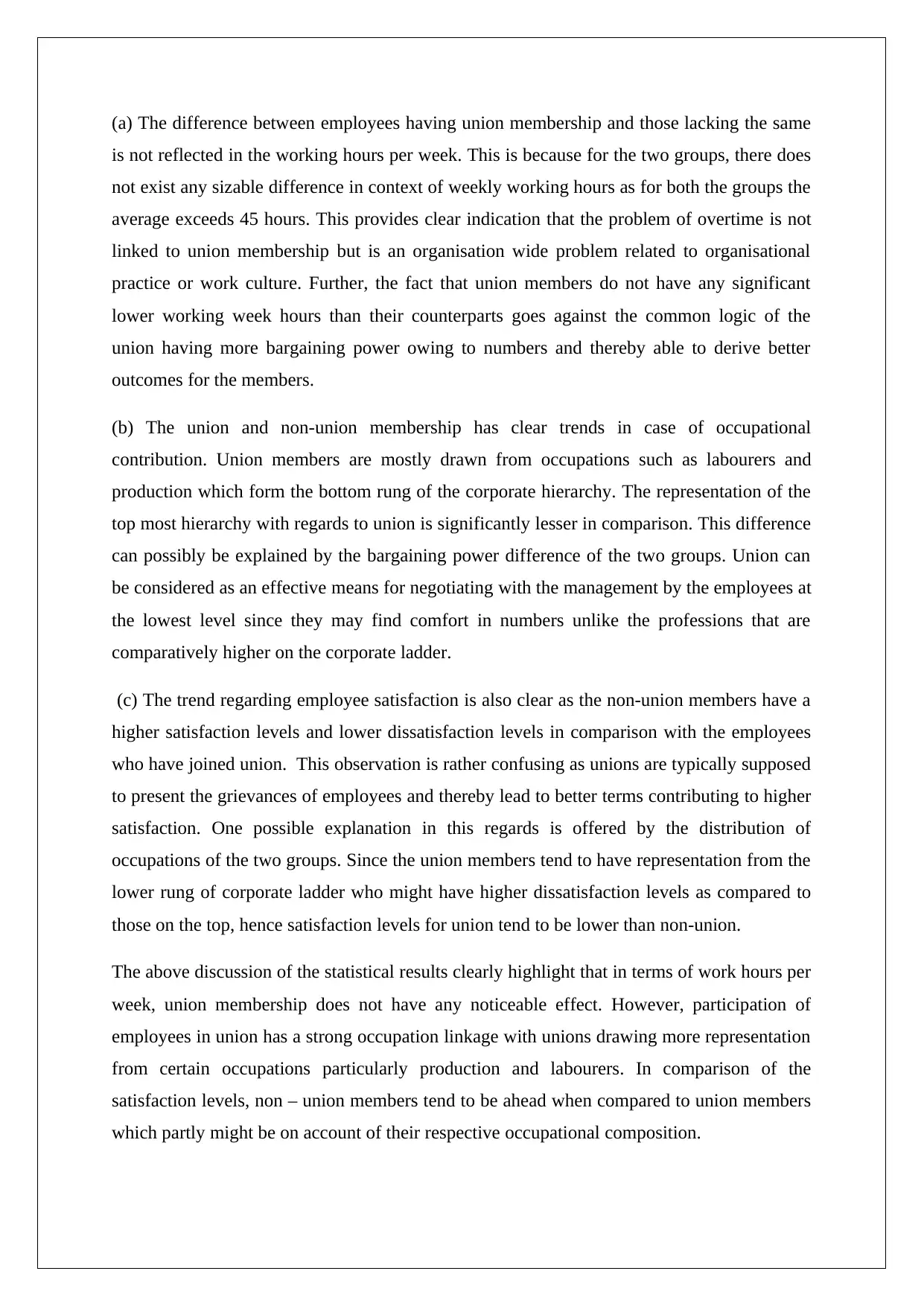
(a) The difference between employees having union membership and those lacking the same
is not reflected in the working hours per week. This is because for the two groups, there does
not exist any sizable difference in context of weekly working hours as for both the groups the
average exceeds 45 hours. This provides clear indication that the problem of overtime is not
linked to union membership but is an organisation wide problem related to organisational
practice or work culture. Further, the fact that union members do not have any significant
lower working week hours than their counterparts goes against the common logic of the
union having more bargaining power owing to numbers and thereby able to derive better
outcomes for the members.
(b) The union and non-union membership has clear trends in case of occupational
contribution. Union members are mostly drawn from occupations such as labourers and
production which form the bottom rung of the corporate hierarchy. The representation of the
top most hierarchy with regards to union is significantly lesser in comparison. This difference
can possibly be explained by the bargaining power difference of the two groups. Union can
be considered as an effective means for negotiating with the management by the employees at
the lowest level since they may find comfort in numbers unlike the professions that are
comparatively higher on the corporate ladder.
(c) The trend regarding employee satisfaction is also clear as the non-union members have a
higher satisfaction levels and lower dissatisfaction levels in comparison with the employees
who have joined union. This observation is rather confusing as unions are typically supposed
to present the grievances of employees and thereby lead to better terms contributing to higher
satisfaction. One possible explanation in this regards is offered by the distribution of
occupations of the two groups. Since the union members tend to have representation from the
lower rung of corporate ladder who might have higher dissatisfaction levels as compared to
those on the top, hence satisfaction levels for union tend to be lower than non-union.
The above discussion of the statistical results clearly highlight that in terms of work hours per
week, union membership does not have any noticeable effect. However, participation of
employees in union has a strong occupation linkage with unions drawing more representation
from certain occupations particularly production and labourers. In comparison of the
satisfaction levels, non – union members tend to be ahead when compared to union members
which partly might be on account of their respective occupational composition.
is not reflected in the working hours per week. This is because for the two groups, there does
not exist any sizable difference in context of weekly working hours as for both the groups the
average exceeds 45 hours. This provides clear indication that the problem of overtime is not
linked to union membership but is an organisation wide problem related to organisational
practice or work culture. Further, the fact that union members do not have any significant
lower working week hours than their counterparts goes against the common logic of the
union having more bargaining power owing to numbers and thereby able to derive better
outcomes for the members.
(b) The union and non-union membership has clear trends in case of occupational
contribution. Union members are mostly drawn from occupations such as labourers and
production which form the bottom rung of the corporate hierarchy. The representation of the
top most hierarchy with regards to union is significantly lesser in comparison. This difference
can possibly be explained by the bargaining power difference of the two groups. Union can
be considered as an effective means for negotiating with the management by the employees at
the lowest level since they may find comfort in numbers unlike the professions that are
comparatively higher on the corporate ladder.
(c) The trend regarding employee satisfaction is also clear as the non-union members have a
higher satisfaction levels and lower dissatisfaction levels in comparison with the employees
who have joined union. This observation is rather confusing as unions are typically supposed
to present the grievances of employees and thereby lead to better terms contributing to higher
satisfaction. One possible explanation in this regards is offered by the distribution of
occupations of the two groups. Since the union members tend to have representation from the
lower rung of corporate ladder who might have higher dissatisfaction levels as compared to
those on the top, hence satisfaction levels for union tend to be lower than non-union.
The above discussion of the statistical results clearly highlight that in terms of work hours per
week, union membership does not have any noticeable effect. However, participation of
employees in union has a strong occupation linkage with unions drawing more representation
from certain occupations particularly production and labourers. In comparison of the
satisfaction levels, non – union members tend to be ahead when compared to union members
which partly might be on account of their respective occupational composition.
Paraphrase This Document
Need a fresh take? Get an instant paraphrase of this document with our AI Paraphraser
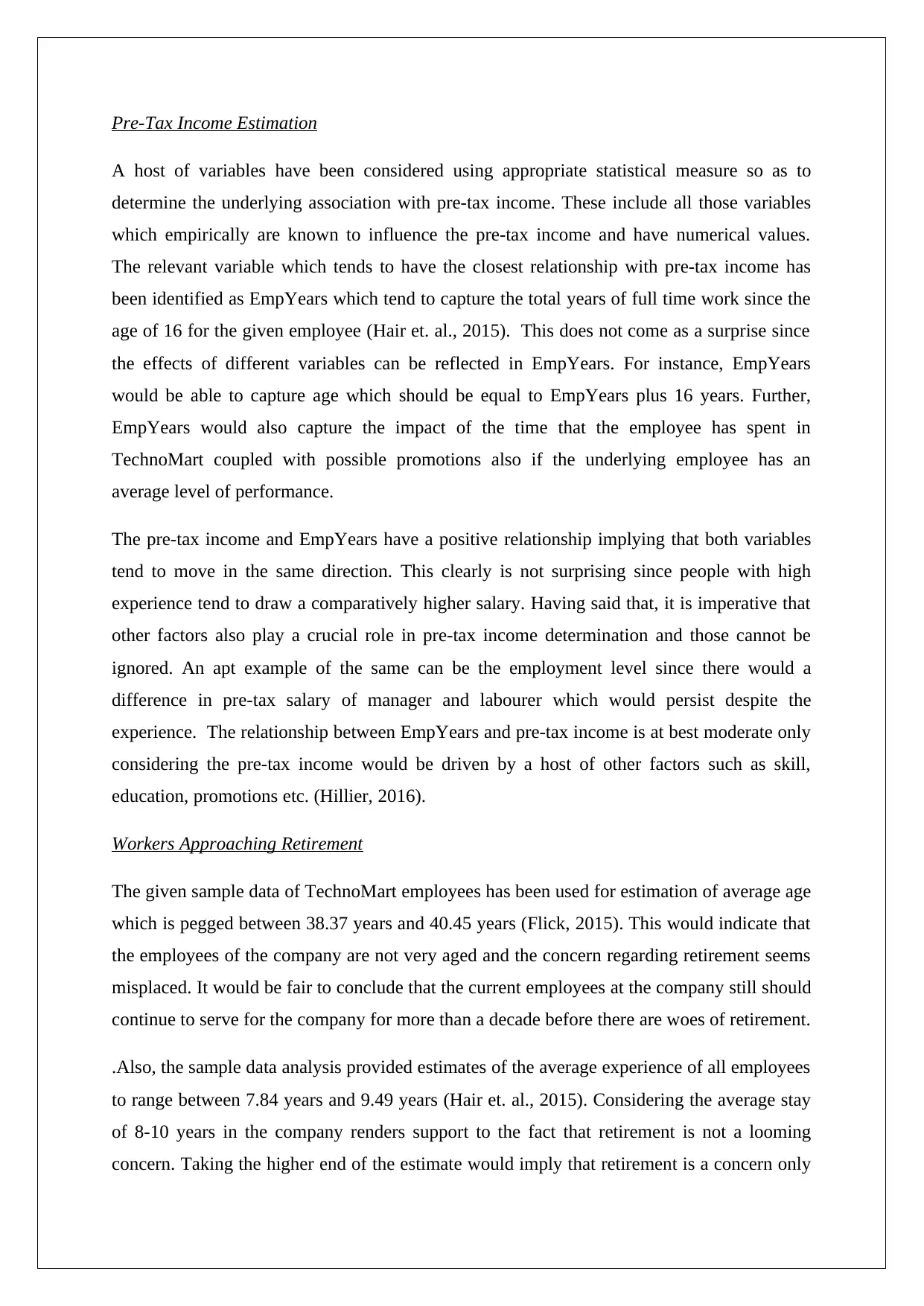
Pre-Tax Income Estimation
A host of variables have been considered using appropriate statistical measure so as to
determine the underlying association with pre-tax income. These include all those variables
which empirically are known to influence the pre-tax income and have numerical values.
The relevant variable which tends to have the closest relationship with pre-tax income has
been identified as EmpYears which tend to capture the total years of full time work since the
age of 16 for the given employee (Hair et. al., 2015). This does not come as a surprise since
the effects of different variables can be reflected in EmpYears. For instance, EmpYears
would be able to capture age which should be equal to EmpYears plus 16 years. Further,
EmpYears would also capture the impact of the time that the employee has spent in
TechnoMart coupled with possible promotions also if the underlying employee has an
average level of performance.
The pre-tax income and EmpYears have a positive relationship implying that both variables
tend to move in the same direction. This clearly is not surprising since people with high
experience tend to draw a comparatively higher salary. Having said that, it is imperative that
other factors also play a crucial role in pre-tax income determination and those cannot be
ignored. An apt example of the same can be the employment level since there would a
difference in pre-tax salary of manager and labourer which would persist despite the
experience. The relationship between EmpYears and pre-tax income is at best moderate only
considering the pre-tax income would be driven by a host of other factors such as skill,
education, promotions etc. (Hillier, 2016).
Workers Approaching Retirement
The given sample data of TechnoMart employees has been used for estimation of average age
which is pegged between 38.37 years and 40.45 years (Flick, 2015). This would indicate that
the employees of the company are not very aged and the concern regarding retirement seems
misplaced. It would be fair to conclude that the current employees at the company still should
continue to serve for the company for more than a decade before there are woes of retirement.
.Also, the sample data analysis provided estimates of the average experience of all employees
to range between 7.84 years and 9.49 years (Hair et. al., 2015). Considering the average stay
of 8-10 years in the company renders support to the fact that retirement is not a looming
concern. Taking the higher end of the estimate would imply that retirement is a concern only
A host of variables have been considered using appropriate statistical measure so as to
determine the underlying association with pre-tax income. These include all those variables
which empirically are known to influence the pre-tax income and have numerical values.
The relevant variable which tends to have the closest relationship with pre-tax income has
been identified as EmpYears which tend to capture the total years of full time work since the
age of 16 for the given employee (Hair et. al., 2015). This does not come as a surprise since
the effects of different variables can be reflected in EmpYears. For instance, EmpYears
would be able to capture age which should be equal to EmpYears plus 16 years. Further,
EmpYears would also capture the impact of the time that the employee has spent in
TechnoMart coupled with possible promotions also if the underlying employee has an
average level of performance.
The pre-tax income and EmpYears have a positive relationship implying that both variables
tend to move in the same direction. This clearly is not surprising since people with high
experience tend to draw a comparatively higher salary. Having said that, it is imperative that
other factors also play a crucial role in pre-tax income determination and those cannot be
ignored. An apt example of the same can be the employment level since there would a
difference in pre-tax salary of manager and labourer which would persist despite the
experience. The relationship between EmpYears and pre-tax income is at best moderate only
considering the pre-tax income would be driven by a host of other factors such as skill,
education, promotions etc. (Hillier, 2016).
Workers Approaching Retirement
The given sample data of TechnoMart employees has been used for estimation of average age
which is pegged between 38.37 years and 40.45 years (Flick, 2015). This would indicate that
the employees of the company are not very aged and the concern regarding retirement seems
misplaced. It would be fair to conclude that the current employees at the company still should
continue to serve for the company for more than a decade before there are woes of retirement.
.Also, the sample data analysis provided estimates of the average experience of all employees
to range between 7.84 years and 9.49 years (Hair et. al., 2015). Considering the average stay
of 8-10 years in the company renders support to the fact that retirement is not a looming
concern. Taking the higher end of the estimate would imply that retirement is a concern only
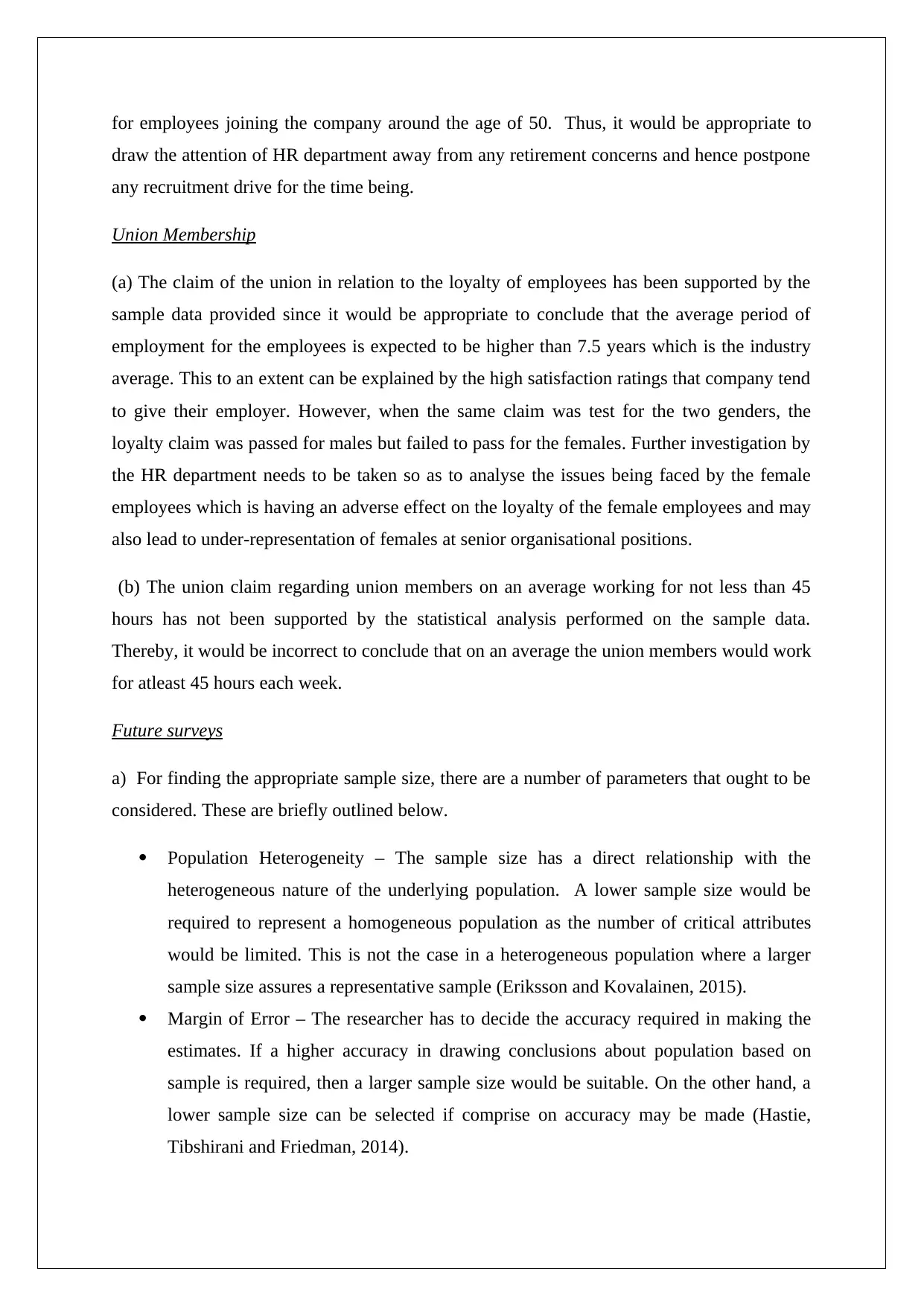
for employees joining the company around the age of 50. Thus, it would be appropriate to
draw the attention of HR department away from any retirement concerns and hence postpone
any recruitment drive for the time being.
Union Membership
(a) The claim of the union in relation to the loyalty of employees has been supported by the
sample data provided since it would be appropriate to conclude that the average period of
employment for the employees is expected to be higher than 7.5 years which is the industry
average. This to an extent can be explained by the high satisfaction ratings that company tend
to give their employer. However, when the same claim was test for the two genders, the
loyalty claim was passed for males but failed to pass for the females. Further investigation by
the HR department needs to be taken so as to analyse the issues being faced by the female
employees which is having an adverse effect on the loyalty of the female employees and may
also lead to under-representation of females at senior organisational positions.
(b) The union claim regarding union members on an average working for not less than 45
hours has not been supported by the statistical analysis performed on the sample data.
Thereby, it would be incorrect to conclude that on an average the union members would work
for atleast 45 hours each week.
Future surveys
a) For finding the appropriate sample size, there are a number of parameters that ought to be
considered. These are briefly outlined below.
Population Heterogeneity – The sample size has a direct relationship with the
heterogeneous nature of the underlying population. A lower sample size would be
required to represent a homogeneous population as the number of critical attributes
would be limited. This is not the case in a heterogeneous population where a larger
sample size assures a representative sample (Eriksson and Kovalainen, 2015).
Margin of Error – The researcher has to decide the accuracy required in making the
estimates. If a higher accuracy in drawing conclusions about population based on
sample is required, then a larger sample size would be suitable. On the other hand, a
lower sample size can be selected if comprise on accuracy may be made (Hastie,
Tibshirani and Friedman, 2014).
draw the attention of HR department away from any retirement concerns and hence postpone
any recruitment drive for the time being.
Union Membership
(a) The claim of the union in relation to the loyalty of employees has been supported by the
sample data provided since it would be appropriate to conclude that the average period of
employment for the employees is expected to be higher than 7.5 years which is the industry
average. This to an extent can be explained by the high satisfaction ratings that company tend
to give their employer. However, when the same claim was test for the two genders, the
loyalty claim was passed for males but failed to pass for the females. Further investigation by
the HR department needs to be taken so as to analyse the issues being faced by the female
employees which is having an adverse effect on the loyalty of the female employees and may
also lead to under-representation of females at senior organisational positions.
(b) The union claim regarding union members on an average working for not less than 45
hours has not been supported by the statistical analysis performed on the sample data.
Thereby, it would be incorrect to conclude that on an average the union members would work
for atleast 45 hours each week.
Future surveys
a) For finding the appropriate sample size, there are a number of parameters that ought to be
considered. These are briefly outlined below.
Population Heterogeneity – The sample size has a direct relationship with the
heterogeneous nature of the underlying population. A lower sample size would be
required to represent a homogeneous population as the number of critical attributes
would be limited. This is not the case in a heterogeneous population where a larger
sample size assures a representative sample (Eriksson and Kovalainen, 2015).
Margin of Error – The researcher has to decide the accuracy required in making the
estimates. If a higher accuracy in drawing conclusions about population based on
sample is required, then a larger sample size would be suitable. On the other hand, a
lower sample size can be selected if comprise on accuracy may be made (Hastie,
Tibshirani and Friedman, 2014).
⊘ This is a preview!⊘
Do you want full access?
Subscribe today to unlock all pages.

Trusted by 1+ million students worldwide
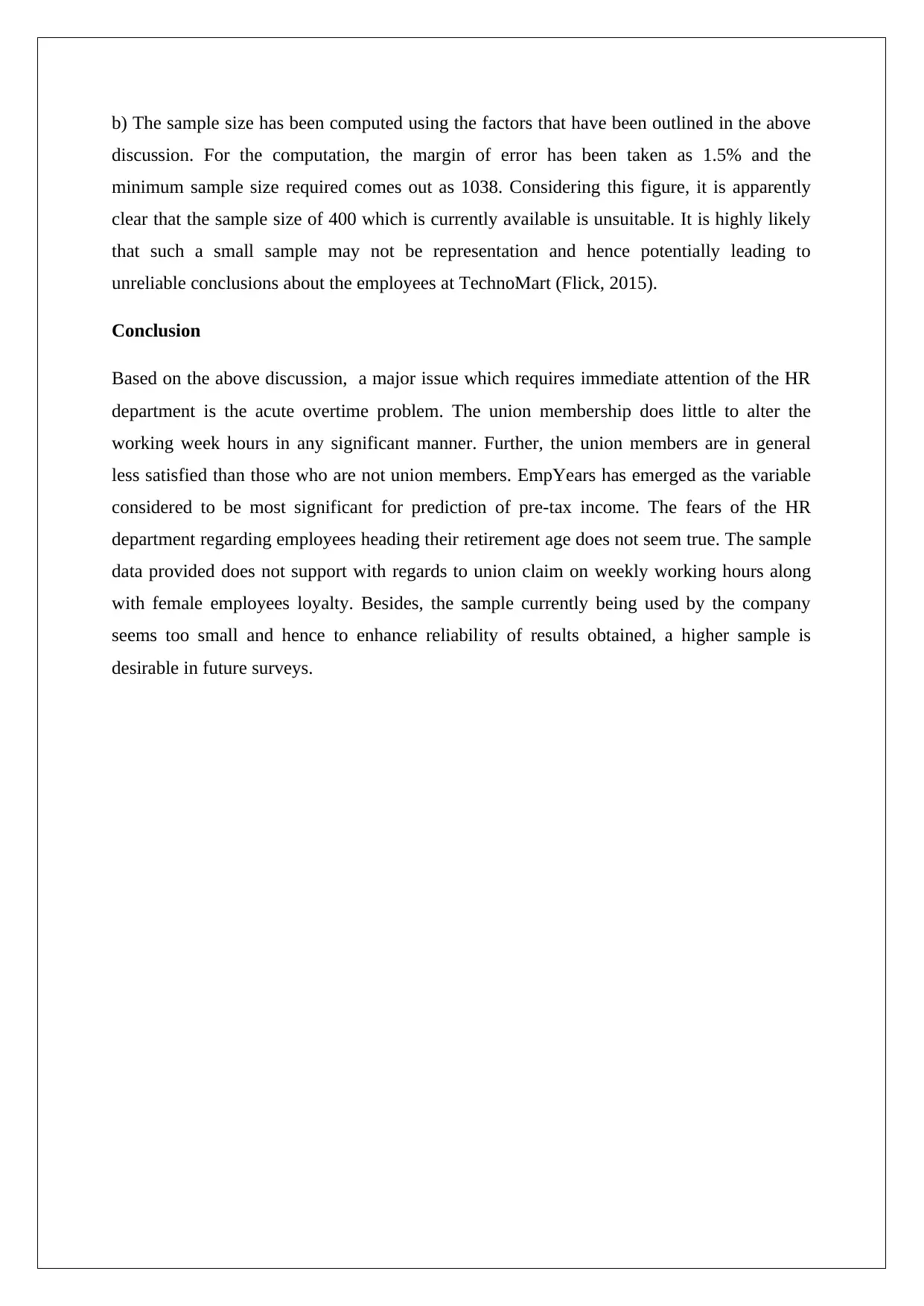
b) The sample size has been computed using the factors that have been outlined in the above
discussion. For the computation, the margin of error has been taken as 1.5% and the
minimum sample size required comes out as 1038. Considering this figure, it is apparently
clear that the sample size of 400 which is currently available is unsuitable. It is highly likely
that such a small sample may not be representation and hence potentially leading to
unreliable conclusions about the employees at TechnoMart (Flick, 2015).
Conclusion
Based on the above discussion, a major issue which requires immediate attention of the HR
department is the acute overtime problem. The union membership does little to alter the
working week hours in any significant manner. Further, the union members are in general
less satisfied than those who are not union members. EmpYears has emerged as the variable
considered to be most significant for prediction of pre-tax income. The fears of the HR
department regarding employees heading their retirement age does not seem true. The sample
data provided does not support with regards to union claim on weekly working hours along
with female employees loyalty. Besides, the sample currently being used by the company
seems too small and hence to enhance reliability of results obtained, a higher sample is
desirable in future surveys.
discussion. For the computation, the margin of error has been taken as 1.5% and the
minimum sample size required comes out as 1038. Considering this figure, it is apparently
clear that the sample size of 400 which is currently available is unsuitable. It is highly likely
that such a small sample may not be representation and hence potentially leading to
unreliable conclusions about the employees at TechnoMart (Flick, 2015).
Conclusion
Based on the above discussion, a major issue which requires immediate attention of the HR
department is the acute overtime problem. The union membership does little to alter the
working week hours in any significant manner. Further, the union members are in general
less satisfied than those who are not union members. EmpYears has emerged as the variable
considered to be most significant for prediction of pre-tax income. The fears of the HR
department regarding employees heading their retirement age does not seem true. The sample
data provided does not support with regards to union claim on weekly working hours along
with female employees loyalty. Besides, the sample currently being used by the company
seems too small and hence to enhance reliability of results obtained, a higher sample is
desirable in future surveys.
Paraphrase This Document
Need a fresh take? Get an instant paraphrase of this document with our AI Paraphraser
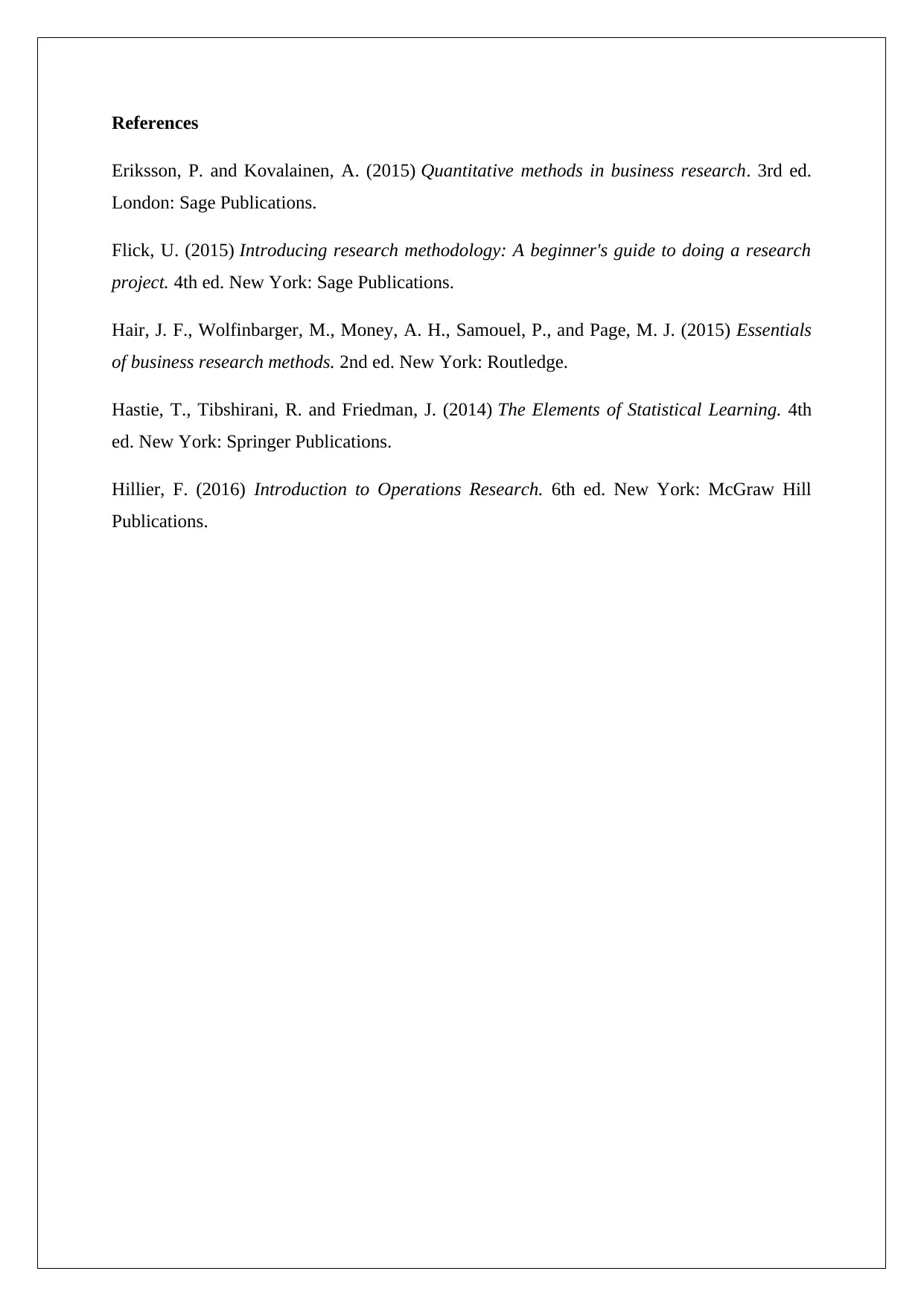
References
Eriksson, P. and Kovalainen, A. (2015) Quantitative methods in business research. 3rd ed.
London: Sage Publications.
Flick, U. (2015) Introducing research methodology: A beginner's guide to doing a research
project. 4th ed. New York: Sage Publications.
Hair, J. F., Wolfinbarger, M., Money, A. H., Samouel, P., and Page, M. J. (2015) Essentials
of business research methods. 2nd ed. New York: Routledge.
Hastie, T., Tibshirani, R. and Friedman, J. (2014) The Elements of Statistical Learning. 4th
ed. New York: Springer Publications.
Hillier, F. (2016) Introduction to Operations Research. 6th ed. New York: McGraw Hill
Publications.
Eriksson, P. and Kovalainen, A. (2015) Quantitative methods in business research. 3rd ed.
London: Sage Publications.
Flick, U. (2015) Introducing research methodology: A beginner's guide to doing a research
project. 4th ed. New York: Sage Publications.
Hair, J. F., Wolfinbarger, M., Money, A. H., Samouel, P., and Page, M. J. (2015) Essentials
of business research methods. 2nd ed. New York: Routledge.
Hastie, T., Tibshirani, R. and Friedman, J. (2014) The Elements of Statistical Learning. 4th
ed. New York: Springer Publications.
Hillier, F. (2016) Introduction to Operations Research. 6th ed. New York: McGraw Hill
Publications.
1 out of 8
Related Documents
Your All-in-One AI-Powered Toolkit for Academic Success.
+13062052269
info@desklib.com
Available 24*7 on WhatsApp / Email
![[object Object]](/_next/static/media/star-bottom.7253800d.svg)
Unlock your academic potential
Copyright © 2020–2025 A2Z Services. All Rights Reserved. Developed and managed by ZUCOL.




